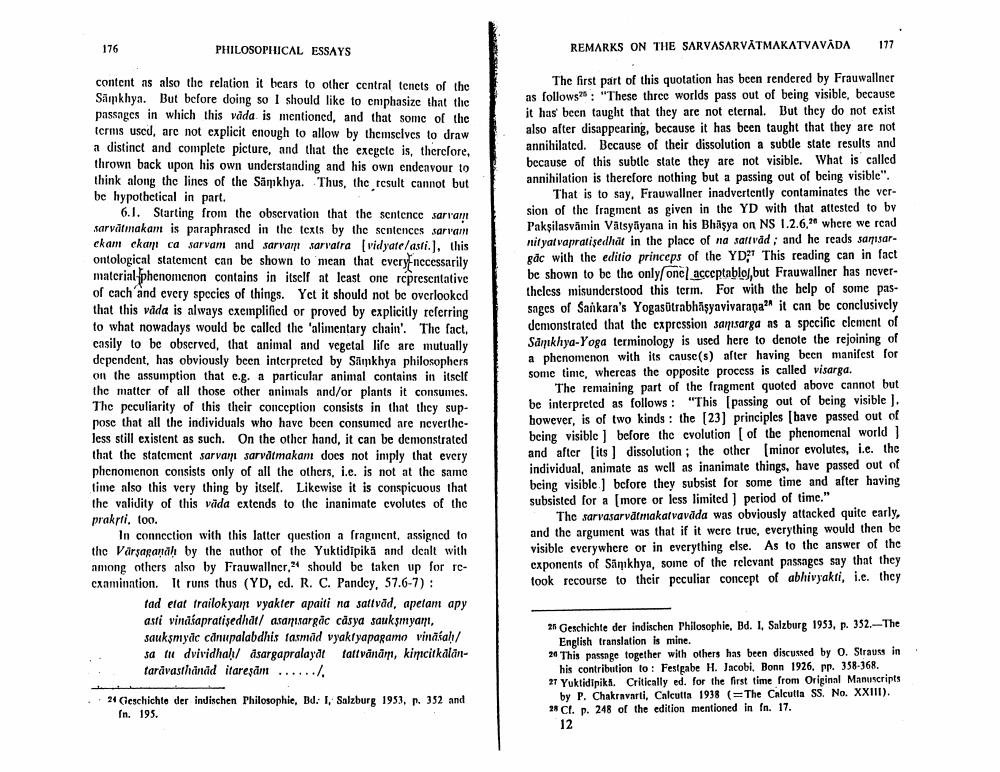Book Title: Remarks On Sarvasarvatmakatvavada Author(s): A Wezler Publisher: A Wezler View full book textPage 6
________________ PHILOSOPHICAL ESSAYS content as also the relation it bears to other central tenets of the Samkhya. But before doing so I should like to emphasize that the passages in which this vada is mentioned, and that some of the terms used, are not explicit enough to allow by themselves to draw a distinct and complete picture, and that the exegete is, therefore, thrown back upon his own understanding and his own endeavour to think along the lines of the Samkhya. Thus, the result cannot but be hypothetical in part. 6.1. Starting from the observation that the sentence sarvan sarvātmakam is paraphrased in the texts by the sentences sarvam ekam ekam ca sarvam and sarvant sarvatra [vidyate/asti.], this ontological statement can be shown to mean that every necessarily material phenomenon contains in itself at least one representative of each and every species of things. Yet it should not be overlooked that this vada is always exemplified or proved by explicitly referring to what nowadays would be called the 'alimentary chain'. The fact, easily to be observed, that animal and vegetal life are mutually dependent, has obviously been interpreted by Samkhya philosophers on the assumption that e.g. a particular animal contains in itself the matter of all those other animals and/or plants it consumes. The peculiarity of this their conception consists in that they sup pose that all the individuals who have been consumed are nevertheless still existent as such. On the other hand, it can be demonstrated that the statement sarvam sarvätmakam does not imply that every. phenomenon consists only of all the others, i.e. is not at the same time also this very thing by itself. Likewise it is conspicuous that the validity of this vada extends to the inanimate evolutes of the prakrti, too. 176 In connection with this latter question a fragment, assigned to the Varsaganah by the author of the Yuktidipika and dealt with among others also by Frauwallner, should be taken up for reexamination. It runs thus (YD, ed. R. C. Pandey, 57.6-7): tad etat trailokyam vyakter apaiti na sattvad, apetam apy asti vinasapratisedhat/ asamsargāc casya sauksmyam, sauksmyac canupalabdhis tasmad vyaktyapagamo vinaśaḥ/ sa tu dvividhaḥ asargapralayat tattvänām, kimcitkäläntarävasthänad itaresăm....... 24 Geschichte der indischen Philosophie, Bd. I, Salzburg 1953, p. 352 and fn. 195. 177 REMARKS ON THE SARVASARVATMAKATVAVADA The first part of this quotation has been rendered by Frauwallner as follows: "These three worlds pass out of being visible, because it has been taught that they are not eternal. But they do not exist also after disappearing, because it has been taught that they are not annihilated. Because of their dissolution a subtle state results and because of this subtle state they are not visible. What is called annihilation is therefore nothing but a passing out of being visible". That is to say, Frauwallner inadvertently contaminates the version of the fragment as given in the YD with that attested to by Paksilasvamin Vätsyäyana in his Bhasya on NS 1.2.6.2 where we read nityatvapratisedhat in the place of na sattvad; and he reads samsargac with the editio princeps of the YD This reading can in fact be shown to be the only one acceptable,but Frauwallner has nevertheless misunderstood this term. For with the help of some pas sages of Sankara's Yogasütrabhasyavivarapa" it can be conclusively demonstrated that the expression samsarga as a specific element of Sankhya-Yoga terminology is used here to denote the rejoining of a phenomenon with its cause(s) after having been manifest for some time, whereas the opposite process is called visarga. The remaining part of the fragment quoted above cannot but be interpreted as follows: "This [passing out of being visible ]. however, is of two kinds: the [23] principles [have passed out of being visible before the evolution [ of the phenomenal world ] and after [its] dissolution; the other [minor evolutes, i.e. the individual, animate as well as inanimate things, have passed out of being visible] before they subsist for some time and after having subsisted for a [more or less limited] period of time." The sarvasarvātmakatvavāda was obviously attacked quite early, and the argument was that if it were true, everything would then be visible everywhere or in everything else. As to the answer of the exponents of Samikhya, some of the relevant passages say that they took recourse to their peculiar concept of abhivyakti, i.e. they 25 Geschichte der indischen Philosophie, Bd. 1, Salzburg 1953, p. 352.-The English translation is mine. 20 This passage together with others has been discussed by O. Strauss in his contribution to: Festgabe H. Jacobi, Bonn 1926, pp. 358-368. 27 Yuktidipika. Critically ed. for the first time from Original Manuscripts by P. Chakravarti, Calcutta 1938 (=The Calcutta SS. No. XXIII). 28 Cf. p. 248 of the edition mentioned in fn. 17. 12Page Navigation
1 ... 4 5 6 7 8
